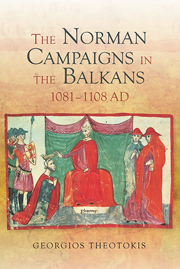Book contents
- Frontmatter
- Contents
- Acknowledgements
- List of abbreviations
- Map I Southern Italy and Sicily
- Map II The island of Sicily
- Map III The southern Balkan peninsula
- Genealogical table: The Norman dukes
- Dedications
- Introduction
- 1 Primary Sources and the Problems of Military History
- 2 Norman Military Institutions in Southern Italy in the Eleventh Century
- 3 The Byzantine Army of the Tenth and Eleventh Centuries
- 4 The Byzantine Naval Forces of the Tenth and Eleventh Centuries
- 5 The Establishment of the Normans in Southern Italy and Sicily
- 6 Robert Guiscard's Invasion of Illyria
- 7 The Norman Advances in the Balkans and the End of the Dream
- 8 Bohemond of Taranto and the First Crusade
- 9 The Count's Campaign of 1107 and the Treaty of Devol
- Conclusions
- List of Byzantine Emperors
- The Hauteville family
- Glossary
- Bibliography
- Index
3 - The Byzantine Army of the Tenth and Eleventh Centuries
Published online by Cambridge University Press: 05 October 2014
- Frontmatter
- Contents
- Acknowledgements
- List of abbreviations
- Map I Southern Italy and Sicily
- Map II The island of Sicily
- Map III The southern Balkan peninsula
- Genealogical table: The Norman dukes
- Dedications
- Introduction
- 1 Primary Sources and the Problems of Military History
- 2 Norman Military Institutions in Southern Italy in the Eleventh Century
- 3 The Byzantine Army of the Tenth and Eleventh Centuries
- 4 The Byzantine Naval Forces of the Tenth and Eleventh Centuries
- 5 The Establishment of the Normans in Southern Italy and Sicily
- 6 Robert Guiscard's Invasion of Illyria
- 7 The Norman Advances in the Balkans and the End of the Dream
- 8 Bohemond of Taranto and the First Crusade
- 9 The Count's Campaign of 1107 and the Treaty of Devol
- Conclusions
- List of Byzantine Emperors
- The Hauteville family
- Glossary
- Bibliography
- Index
Summary
The Byzantine army constantly evolved throughout its history. A worthy successor to the vast mechanism set up by the Romans, its most remarkable trait was the degree of adaptability that characterised it as an institution, along with the open-minded attitude of its officers and the tactics they applied in the battlefield. Numerous military manuals, such as Maurice's Strategikon, Leo VI's Taktika, the Praecepta Militaria of Nicephorus Phocas, the Taktika of Nicephorus Uranus and the Strategikon of this parish Cecaumenus, offer us a thorough look into the way Byzantine officers thought and how they faced their enemies in each operational theatre. They had two distinct but mutually supportive mechanisms, which had been established since the eighth century: the themata, armies which were defensive in nature and whose main objective was to intercept and harass any invading army, and the tagmata, professional units trained to deliver the final blow to the enemy on pitched battle.
The army that Alexius Comnenus deployed against the Normans in 1108 was different in both structure and make-up from that which Romanus IV Diogenes had gathered for his Turkish campaigns that culminated in the battle of Manzikert in 1071. The old thematic and tagmatic units (indigenous troops that formed the backbone of the army's structure for centuries) were largely replaced by mercenaries. Alexius Comnenus depended on the hiring of large bodies of paid troops of any ethnic background for long-term military service, like the Varangian Guard (largely comprised of Anglo-Saxons after 1081), the German Nemitzi and several Frankish regiments.
- Type
- Chapter
- Information
- The Norman Campaigns in the Balkans, 1081-1108 AD , pp. 58 - 91Publisher: Boydell & BrewerPrint publication year: 2014



